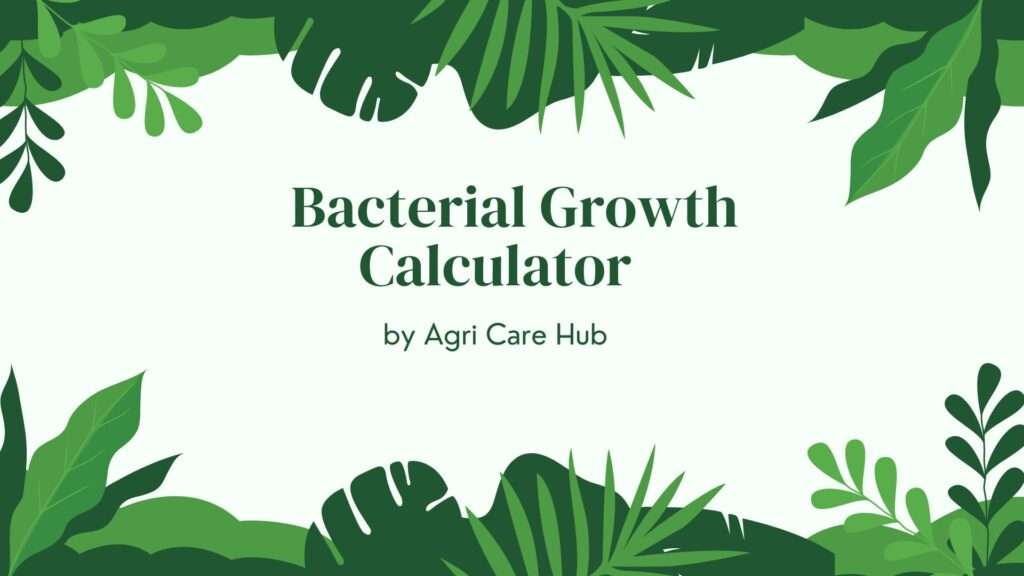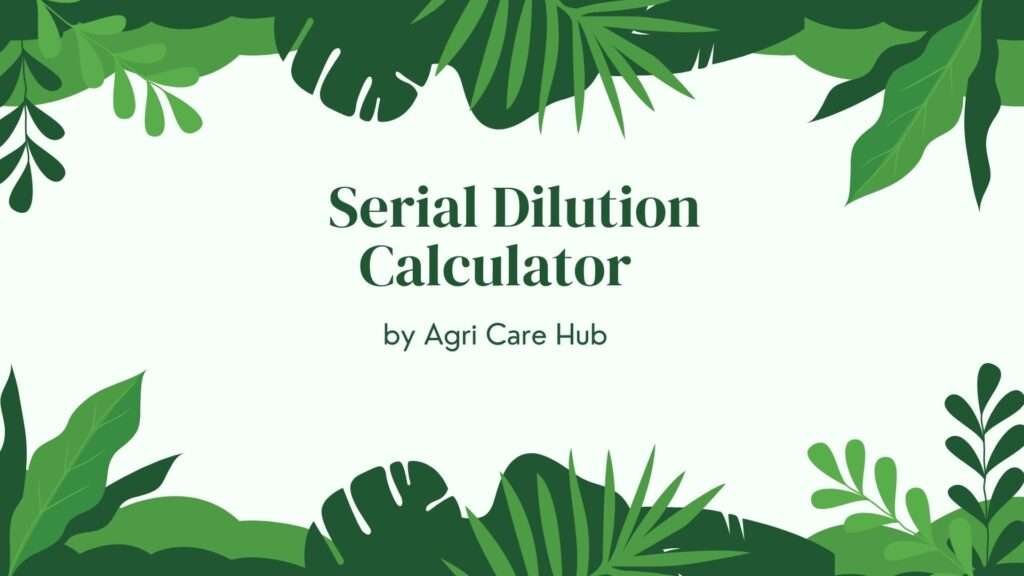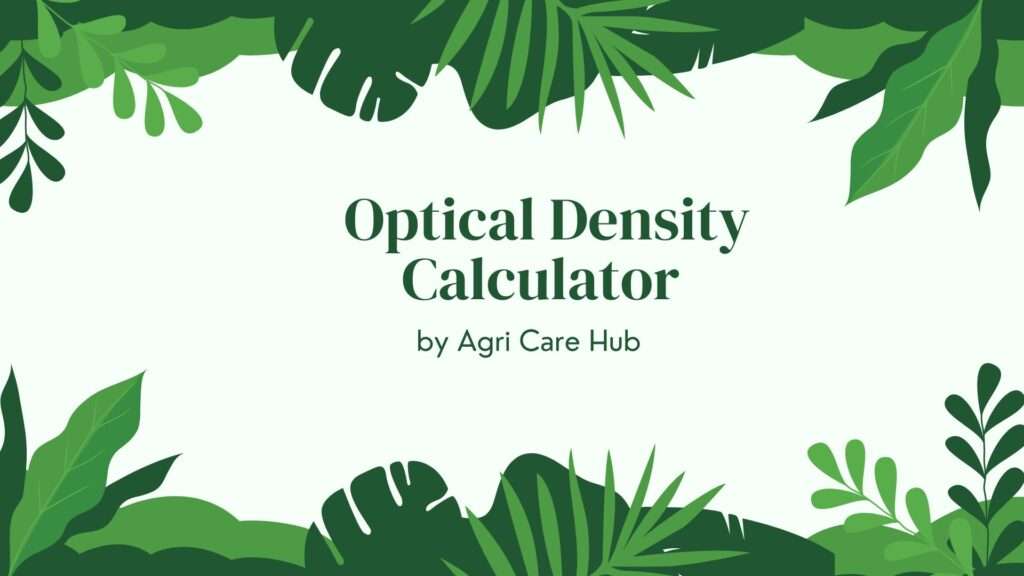OD600 Calculator
About the OD600 Calculator
The OD600 Calculator is a scientifically validated tool designed to estimate bacterial cell density in a liquid culture based on optical density measurements at 600 nm (OD600). Provided by Agri Care Hub, this calculator uses the formula Cell Density = OD600 × Calibration Factor, where the calibration factor is specific to the bacterial species and spectrophotometer used. This peer-reviewed method, widely applied in microbiology, ensures accurate quantification of bacterial populations for agricultural and environmental research.
Importance of the OD600 Calculator
The OD600 Calculator is a critical tool in microbiology, agriculture, and biotechnology, enabling researchers and professionals to measure bacterial cell density quickly and accurately. In agriculture, understanding microbial populations in soil or liquid cultures is essential for optimizing biofertilizers, biocontrol agents, and soil health management. For instance, high cell densities of beneficial bacteria like Bacillus can enhance crop growth, while excessive pathogen density may indicate contamination risks. In environmental science, OD600 measurements help monitor microbial activity in water or bioremediation processes, supporting sustainable practices and ecosystem health.
User Guidelines
<}p>To use the OD600 Calculator effectively, follow these steps:- Enter OD600 Measurement: Input the optical density reading at 600 nm, typically obtained using a spectrophotometer. Ensure the value is within the linear range (e.g., 0.1–1.0) for accuracy.
- Enter Calibration Factor: Provide the calibration factor (cells/mL per OD600 unit), which is specific to the bacterial species and instrument. A common default is 8 × 10^8 cells/mL for E. coli, but verify with your laboratory standards.
- Calculate: Click the "Calculate Cell Density" button to compute the bacterial cell density.
- Review Results: The calculator will display the cell density in cells/mL, with validation to ensure inputs are non-negative.
For accurate results, ensure the OD600 measurement is taken within the spectrophotometer’s linear range and the calibration factor is validated for your specific bacterial strain and equipment. Dilute samples if the OD600 exceeds 1.0 to avoid inaccuracies due to light scattering.
The OD600 Calculator is ideal for various applications:
- Agricultural Microbiology: Assess the density of beneficial or pathogenic bacteria in soil or liquid cultures to optimize biofertilizer applications or control disease.
- Environmental Monitoring: Monitor microbial populations in water or soil samples for bioremediation or water quality assessments.
- Biotechnology: Measure bacterial growth in fermentation processes for producing biofuels, enzymes, or pharmaceuticals.
- Research and Education: Support microbiology experiments and teaching by providing quick and accurate cell density estimates.
By offering precise cell density calculations, the OD600 Calculator reduces the need for time-consuming manual methods, enabling data-driven decisions in these fields.
Purpose of the OD600 Calculator
The primary purpose of the OD600 Calculator is to provide a user-friendly, scientifically reliable tool for estimating bacterial cell density based on optical density measurements. This tool supports agricultural, environmental, and biotechnological applications by delivering accurate cell density data using standardized methods. It empowers users to monitor microbial populations, optimize agricultural practices, and advance research, contributing to sustainable outcomes, as championed by Agri Care Hub.
Scientific Basis of the Calculator
The OD600 Calculator is grounded in the principle of turbidimetry, which measures the turbidity of a bacterial suspension using optical density at 600 nm. The OD600 value is proportional to cell density within a linear range, as described by the Beer-Lambert Law, though deviations occur at high densities due to multiple scattering. The formula Cell Density = OD600 × Calibration Factor is widely used in microbiology, as detailed in resources like OD600 Calculator. The calibration factor accounts for species-specific light scattering properties and is typically determined through plate counting or flow cytometry. The calculator includes input validation to ensure reliable results.
Applications in Agriculture
In agriculture, bacterial cell density is a key indicator of soil and plant health. Beneficial microorganisms, such as Rhizobium or Pseudomonas, enhance nutrient availability and protect against pathogens, while high densities of harmful bacteria can lead to crop diseases. The OD600 Calculator enables farmers to quantify these populations in liquid cultures or soil extracts, supporting decisions on biofertilizer application or pathogen control. For example, a high cell density of nitrogen-fixing bacteria may indicate optimal conditions for legume crops, while a high pathogen density may prompt biocontrol measures.
Relevance to Environmental Science
In environmental science, the OD600 Calculator is used to monitor microbial populations in water, soil, or bioremediation systems. For instance, it can quantify bacteria involved in degrading pollutants, such as hydrocarbons in contaminated soils, aiding in bioremediation strategies. It also supports water quality assessments by measuring microbial loads in water samples, which is critical for ensuring safe irrigation or drinking water. By providing accurate cell density data, the calculator enhances environmental monitoring and contributes to sustainable ecosystem management.
Benefits of Using the Calculator
The OD600 Calculator offers several advantages:
- Accuracy: Based on standardized turbidimetric methods, ensuring reliable cell density estimates.
- Simplicity: An intuitive interface that simplifies complex calculations, suitable for professionals and students.
- Versatility: Applicable in agriculture, environmental science, biotechnology, and education.
- Efficiency: Instant calculations save time compared to manual plate counting or other methods.
These benefits make the calculator an essential tool for anyone working with bacterial cultures.
Limitations and Considerations
While the OD600 Calculator is accurate within the linear range of OD600 measurements (typically 0.1–1.0), it has limitations. High OD600 values may lead to inaccuracies due to multiple light scattering, requiring sample dilution. The calibration factor is species- and instrument-specific, so users must validate it for their setup. Additionally, OD600 measures total turbidity, including dead cells or debris, so it may overestimate viable cells. For precise viable cell counts, combine OD600 with plate counting or flow cytometry. Consulting a microbiologist for complex samples is recommended.
Integration with Sustainable Practices
The OD600 Calculator supports sustainable practices by enabling precise microbial monitoring. In agriculture, it optimizes the use of biofertilizers and biocontrol agents, reducing reliance on chemical inputs and minimizing environmental impact. In environmental science, it supports bioremediation and water quality monitoring, contributing to ecosystem health. By providing reliable data, the calculator aligns with the mission of Agri Care Hub to promote sustainable agricultural and environmental practices, ensuring efficient resource use.
Conclusion
The OD600 Calculator is a powerful, science-based tool for professionals and researchers in microbiology, agriculture, and environmental science. By delivering accurate and instant cell density calculations, it supports soil health management, environmental monitoring, and biotechnological research. Whether you’re a farmer optimizing microbial applications or a scientist studying bioremediation, this calculator, offered by Agri Care Hub, provides the precision and reliability needed to make informed decisions. Use the tool today to enhance your microbiological workflows.













